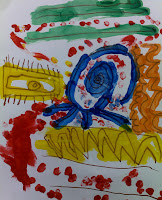DelCampo Academy Art...
it's the process not the product!
Monday, October 25, 2010
Sunday, September 26, 2010
Second grade fish skeleton
Second graders were given a set of cut paper shapes. They had to create a fish skeleton using all the pieces given. Check out the product!
kinder Lines
Wednesday, September 22, 2010
Ten Lessons the Arts Teach
1. The arts teach children to make good judgments about qualitative relationships.
Unlike much of the curriculum in which correct answers and rules prevail, in the arts, it
is judgment rather than rules that prevail.
Unlike much of the curriculum in which correct answers and rules prevail, in the arts, it
is judgment rather than rules that prevail.
2. The arts teach children that problems can have more than one solution
and that questions can have more than one answer.
and that questions can have more than one answer.
3. The arts celebrate multiple perspectives.
One of their large lessons is that there are many ways to see and interpret the world.
One of their large lessons is that there are many ways to see and interpret the world.
4. The arts teach children that in complex forms of problem solving
purposes are seldom fixed, but change with circumstance and opportunity. Learning in the arts requires the ability and a willingness to surrender to the unanticipated possibilities of the work as it unfolds.
purposes are seldom fixed, but change with circumstance and opportunity. Learning in the arts requires the ability and a willingness to surrender to the unanticipated possibilities of the work as it unfolds.
5. The arts make vivid the fact that neither words in their literal form nor number exhaust what we can know. The limits of our language do not define the limits of our cognition.
6. The arts teach students that small differences can have large effects.
The arts traffic in subtleties.
The arts traffic in subtleties.
7. The arts teach students to think through and within a material.
All art forms employ some means through which images become real.
All art forms employ some means through which images become real.
8. The arts help children learn to say what cannot be said.
When children are invited to disclose what a work of art helps them feel, they must reach into their poetic capacities to find the words that will do the job.
When children are invited to disclose what a work of art helps them feel, they must reach into their poetic capacities to find the words that will do the job.
9. The arts enable us to have experience we can have from no other source
and through such experience to discover the range and variety of what we are capable of feeling.
and through such experience to discover the range and variety of what we are capable of feeling.
10. The arts’ position in the school curriculum symbolizes to the young
what adults believe is important.
SOURCE: Eisner, E. (2002). The Arts and the Creation of Mind,Ten Lessons with proper acknowledgment of its source and NAEA. In Chapter 4, What the Arts Teach and How It Shows. (pp. 70-92)
what adults believe is important.
SOURCE: Eisner, E. (2002). The Arts and the Creation of Mind,Ten Lessons with proper acknowledgment of its source and NAEA. In Chapter 4, What the Arts Teach and How It Shows. (pp. 70-92)
Tuesday, September 21, 2010
ELECTIVE ART
A stencil is a template used to draw or paint identical letters, numbers, symbols, shapes or patterns. Stencils are formed by removing sections from template material in the form of text or image. This creates what is essentially a physical negative. The template can be then used to create impressions by applying pigment in form of paint. Here's what Mr. A. Romero from grade 9 has done so far. Can you identify these characters?
A stencil is a template used to draw or paint identical letters, numbers, symbols, shapes or patterns. Stencils are formed by removing sections from template material in the form of text or image. This creates what is essentially a physical negative. The template can be then used to create impressions by applying pigment in form of paint. Here's what Mr. A. Romero from grade 9 has done so far. Can you identify these characters?
Subscribe to:
Comments (Atom)















































